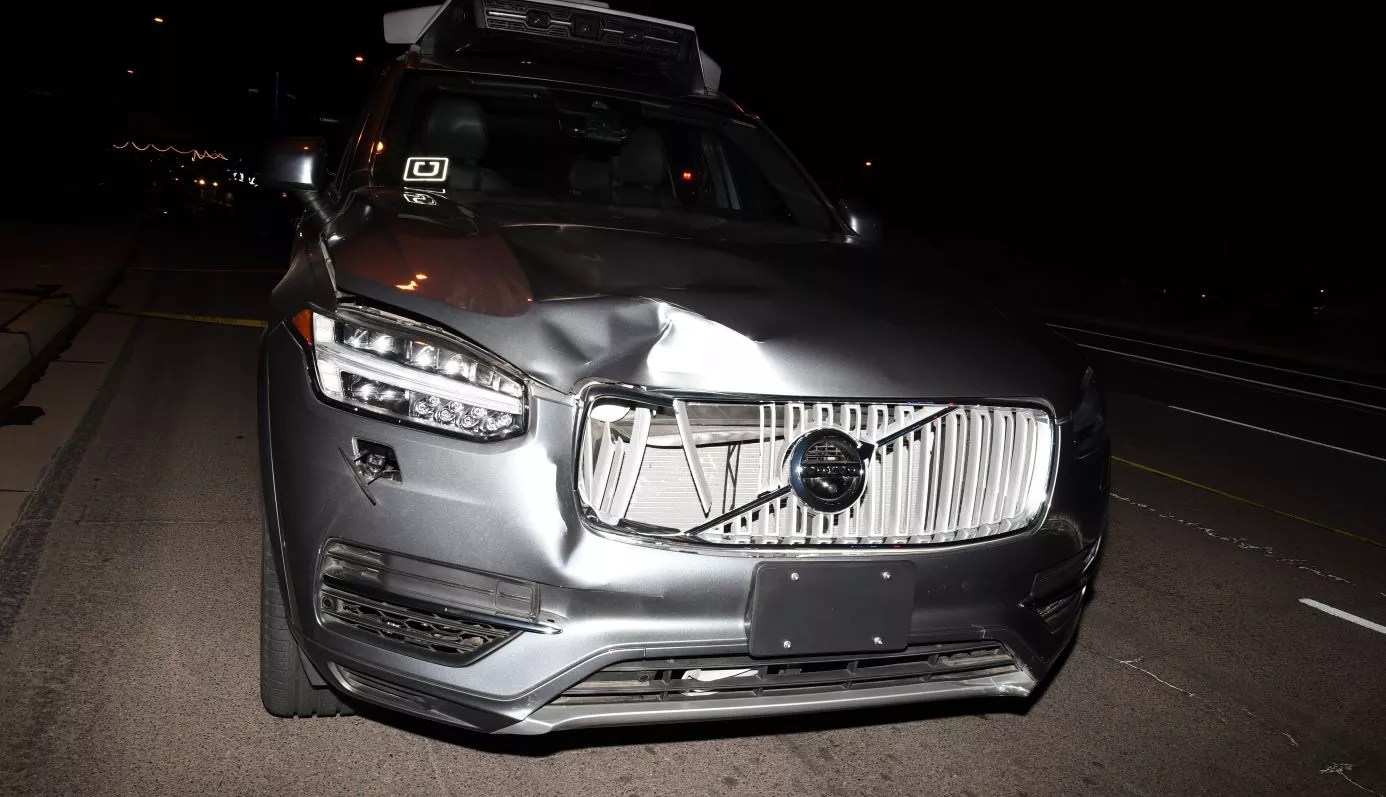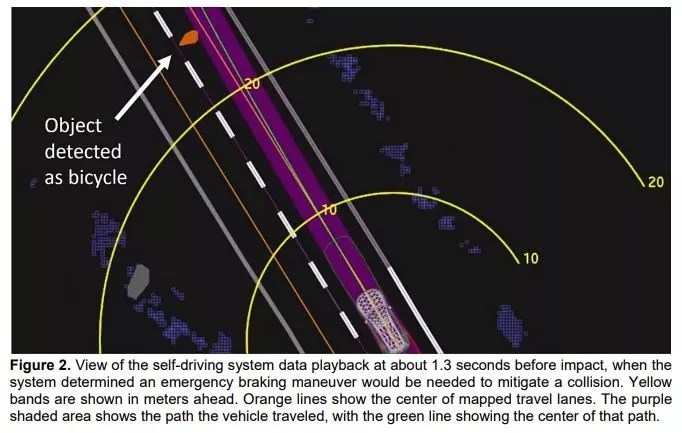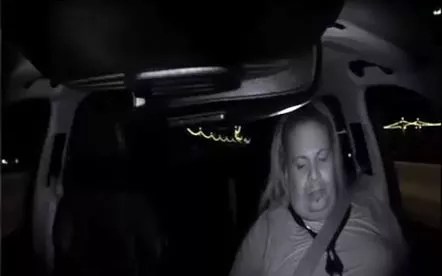
Tempe Police

Audio By Carbonatix
No doubt, Rafaela Vasquez should have seen pedestrian Elaine Herzberg sooner on March 18, 2018, and taken action before the autonomous Uber vehicle she was riding in hit and killed her.
Widely seen interior video from a camera inside the Volvo SUV shows that Vasquez was not looking at the road in the seconds before the impact.
But there’s far more to the story than that, and Vasquez’s defense team says the grand jury didn’t get to hear information critical to the case before deciding to indict her last September on a charge of negligent homicide. Yavapai County Attorney Sheila Polk decided that Uber was not criminally liable in the crash in March 2019.
Her private lawyers, Albert Morrison and Marci Kratter, filed an extensive motion in Maricopa County Superior Court on Tuesday demanding that the case be remanded back to the grand jury for a new determination of probable cause.
The 83-page motion makes a strong case for the idea that Uber’s irresponsible safety practices were even more to blame for the fatal crash than Vasquez, and argues that police and an unnamed prosecutor with the Maricopa County Attorney’s Office withheld key facts that reveal Uber’s culpability, gave misleading facts, and failed to explain the law properly.
It claims that the grand jury should have heard that the National Transportation Safety Board (NTSB) had serious concerns about Uber’s role in the crash, that Uber had unsafe practices, that a whistleblower from Uber had revealed even more unsafe practices to a Tempe detective, and that Vasquez wasn’t looking at her phone just before the crash, as investigators had claimed.
The county attorney’s office has yet to file a response to the motion and declined comment for this article. Uber failed to answer messages about the motion this week.
Kratter and Morrison declined comment on their motion, and Phoenix New Times was unable to reach Vasquez.
Tempe police released a statement on Wednesday denying there were problems with its investigation: “As the investigation is ongoing we will not provide comment on the allegation made in the motion to remand. Tempe Police Traffic Detectives completed a through and accurate investigation. We stand behind the information included in the investigation and believe them to be truthful.”
A new trial date has been tentatively set for August 10, but is likely to be delayed again due to the complexity of the high-profile case.
Crash Probe
The Tempe crash marked the world’s first pedestrian killed by a self-driving car and sparked worldwide headlines in 2018, setting back the fledgling autonomous vehicle industry. The technology was supposed to make people safer, and experts were stunned when Uber’s car failed to perform as expected.
The modified Volvo XC90 had radar, lidar, 10 cameras, and other sensors and was in autonomous mode the night of the crash, with Vasquez monitoring – hands and feet free – as the vehicle drove in a long loop through downtown Tempe. It entered the northbound Mill Avenue bridge going just over 40 mph just before 10 p.m. At about the same time, Elaine Herzberg, a 49-year-old homeless woman with meth in her bloodstream, began to cross the same street from a dark median to the vehicle’s left. The investigation showed she almost made it to the east-side curb before the vehicle struck her without braking.
It was Uber, according to Vasquez’s defense team, that should have seen the crash coming. Morrison and Kratter argue in the motion that the California company, with help from Governor Doug Ducey and Tempe police, intentionally risked the safety of the public and its backup drivers to try and stay competitive in the global race to build self-driving cars. The motion relies heavily on a report from the NTSB, which provided numerous points on how Uber’s lack of appropriate safety measures contributed to the crash.
That same NTSB report, released in November 2019, stated that the “probable cause of the crash” was Vasquez’s inattentiveness “because she was visually distracted throughout the trip by her personal cell phone.” A report on the artificial lighting on the bridge reviewed by Tempe police concluded that even a motorist driving with no headlights should have been able to see the jaywalking pedestrian up to 1,700 feet away, with plenty of time to avoid her.
Vasquez had been lulled into complacency by the tedious nature of the job and the company’s assurances that the Volvo’s stock automatic-braking system was working in tandem with the autonomous functions, according to the defense motion.

NTSB
As investigators found in 2018, the Uber cars were programmed to disable their auto-braking features when the cars were in autonomous mode. A later study showed that the car almost certainly would have stopped for Herzberg had the manufacturer-installed system not been disabled, the motion points out.
“Due to an excessive number of minor accidents occurring as drivers were leaving the parking garage to begin their shifts, Uber told the drivers that [the Volvo’s auto-braking functions] were activated full time,” and Vasquez didn’t know the features had been disabled, the motion states. The motion doesn’t, however, explain why minor accidents would lead the company to do that.
In general, the motion focuses on the idea that the jury should have heard more about Uber’s unsafe practices and how Tempe police and Uber worked together to reach the conclusion that Vasquez had committed a crime. It begins with an alleged quote that Uber CEO Dara Khosrowshahi sent to Uber executives on March 19, 2018, one day after the crash: “We can afford to make mistakes. We can’t afford to slow down.” The origin of the quote isn’t stated.
“But for Uber’s many and varied failures, the collision and Ms. Herzberg’s death would likely have never happened,” the motion states, adding that the city of Tempe, the state of Arizona, and Uber “all shared a common goal of avoiding legal liability for Ms. Herzberg’s death.”
The Whistleblower
In investigating the crash, Uber worked “hand-in-glove” with Tempe police, “who delegated much of the investigation to Uber and the company’s influence colored TPD’s conclusions,” it states.
One consequence of the supposed collaboration described by the motion is how Tempe failed to follow up on the allegations by an Uber whistleblower who called a Tempe detective “shortly after the accident” with information. The person said they had already contacted the NTSB and gave their name and contact information, which wasn’t revealed in the motion.
Previously published articles about a whistleblower related to the crash referred to Robbie Miller, a former Uber operations manager who – just before he quit – sent an email to his superiors on March 13 that was revealed to Amir Efrati of TheInformation.com for a December 2018 article. Miller’s email, as the article describes, fretted about allegedly frequent minor crashes and how managers “ignored” safety concerns.
The whistleblower who contacted Tempe police was a “technical program manager” who apparently still worked for Uber. He talked for 48 minutes to Tempe Detective Tom Haubold, (whose first name isn’t given, and whose last name is misspelled as Hauboldt in the motion), providing a “damning account of Uber’s utter disregard for the safety of the public or its employees…” and of the company’s “culpability” in the Vasquez case.
“The Whistleblower also claimed to have access to documents that would corroborate his claims, documents that the detective never requested or sought to obtain, despite the fact that he knew them to be exculpatory,” the motion states. “According to The Whistleblower, focusing on Ms. Vasquez and her conduct ignored the larger problem. Greed drove Uber to ignore known risks.”
Tempe police don’t mention the call in a report, and it wasn’t brought up before the grand jury. Some of the caller’s information was used in the NTSB’s final report on the crash, says the motion – a claim that is not readily apparent by reading the report, which doesn’t mention a whistleblower.
The motion also says the whistleblower gave Haubold the name of an expert in “automation complacency” to call, but he “never contacted the expert.”
The NTSB’s final report covers automation complacency extensively; it’s a well-known effect on employees expected to monitor automated devices. While the NTSB blamed Vasquez primarily, most of the report is about the failures of Uber’s Advanced Technologies Group, the division charged with developing autonomous vehicles, which all contributed to Vasquez’s inattention. Frequent reviewing of the vehicles’ interior cabins would have revealed complacency and other errors by the backup drivers that could have been corrected, according to the agency. Vasquez, for example, was never reported for any safety infractions and wasn’t disciplined for anything while employed by Uber.
The NTSB found that Uber ATG “did not adequately recognize the risk of automation complacency and develop effective countermeasures to control the risk of vehicle operator disengagement, which contributed to the crash.”
Also critical was the removal of a second backup driver from the vehicles five months before the crash, as the NTSB report and the whistleblower who called Haubold noted.
“Removal of the second occupant meant that the operator would do her job plus the job of the second operator and recognize when the system failed in sufficient time to intervene and prevent a problem. The Whistleblower told the detective that that calculation was irresponsibly flawed,” the motion says.
The grand jury that charged Vasquez should have heard all that and more, her lawyers argue.
Whose Phone?
In the video of the interior of the crash vehicle released by Uber, Vasquez can be seen glancing down near the center console and smirking, as if she’d just seen or heard something amusing just before she looks up in surprise before the crash.
Police say they have proof her phone was streaming The Voice on Hulu at the time of the crash.
Vasquez’s lawyers, in the motion, say they can prove she wasn’t actually watching the show at the time. Backup drivers were allowed to have an Uber-provided phone in the vehicle and could use it to chat on Slack with the company “while on the road,” the motion states. That’s the phone that was near Vasquez’s right knee by the center console, it says.
The motion notes that Detective Haubold, in a report he filed after the crash, stated: “Given the findings from Hulu regarding the driver’s personal phone streaming video during the time of the crash, as well as the video of the driver pulling her phone out of her purse at the beginning of the dashcam footage of her shift at around the time the Hulu streaming began, it is likely that the driver was focused on the streaming media on her phone instead of her duties…”

Rafaela Vasquez wasn’t looking at the road just before the crash.
Tempe Police
But video reviewed by the lawyers shows clearly that Vasquez pulled the Uber phone in its black case from her purse and placed it near the center console, not her personal cell phone, which had a gold case and was on the passenger seat. The Uber phone had only one media app, YouTube, and police forensics further showed that it was the phone from the gold case that had been streaming Hulu.
Vasquez, while driving, was listening to the show on an earpiece, which Uber allowed, the motion says.
One problem, though, is that the theory doesn’t fully account for why Vasquez kept looking at the center console, as can be seen in the interior video.
The NTSB report states that Uber backup drivers were tasked with “monitoring diagnostic messages that appear on an interface in the center stack of the vehicle dash and tagging events of interest for subsequent review.”
Vasquez told Tempe police just after the crash that she was “monitoring the self-driving interface” just before the impact.
Uber told New Times in 2018 that backup drivers aren’t trained to look at the diagnostics while the car is in motion. Video reviewed by the NTSB showed that during one of her loops the night of the crash, Vasquez’s gaze was focused on the spot below the dashboard for a full 26 minutes.
The NTSB report, which Vasquez’s lawyers argue the grand jury should have heard more about, states that Vasquez placed her personal phone near the center console and that it was streaming Hulu for 39 minutes, or the entire time she was driving on the trip that led to the crash. During that time, she spent 34 percent of her time “looking at her cell phone,” the NTSB found.
Argument
Besides not receiving all the relevant information in the case, the grand jury was also poorly instructed on the relevant laws, the motion says.
“Causation is an element of Negligent Homicide,” it says, implying that the charge should have taken into account “additional casual results.”
The grand jury wasn’t instructed on that law, and the case should be remanded on that basis alone, the motion says.
It continues that a Tempe detective told the grand jury “that he never really considered the effect of automation” on a backup driver and said he based the driver’s responsibility by “what would be expected of most people.”
That was clearly inappropriate in this complicated, high-tech case, the motion suggests.
Following the crash, Uber moved its self-driving operations out of Arizona. In December, it sold its self-driving division to Aurora Innovation Inc.
Remanding a case back to the grand jury is often seen as a long shot, but sometimes it’s an effective way to stop a prosecution cold. Last month, the county attorney’s office moved to dismiss the criminal case against motorist Jerry Sanstead after, in seeming contrast to the story given to the grand jury, evidence surfaced that he wasn’t texting and driving before killing Salt River tribal police officer Clayton Townsend in a 2019 crash.
Numerous other alleged falsities or unacceptable omissions in the state’s presentation are covered in the lengthy motion. You can read the entire document below: